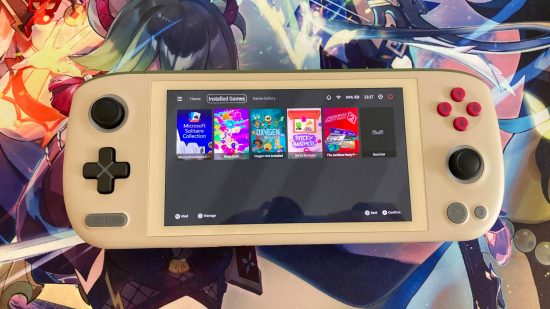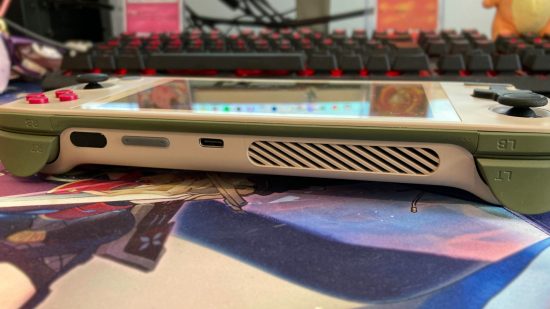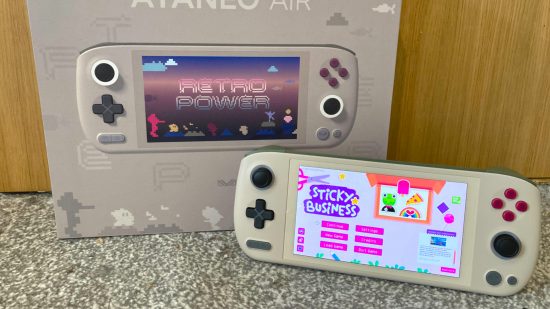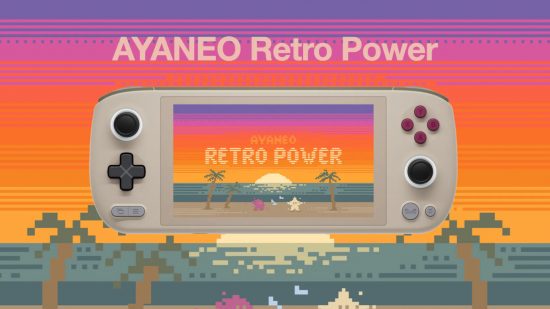Ayaneo Air 1S review – ‘air’ on the side of caution

I love playing games on my Nintendo Switch sat on the sofa next to my partner – it’s how we spend most of our time together – but sometimes I want to play one of the many cool games that I have on PC while still spending time with them. Usually, this is pretty impossible as my PC is in a completely different room of the house, which is why I was super excited to give a handheld PC a try for this Ayaneo Air 1S review. Getting to experience PC-level gameplay from the comfort of my sofa sounds like a perfect combination. Let’s see if this powerful bit of kit lives up to my expectations.
The Ayaneo Air 1S is far from the only handheld PC on the market, so if you’re after something a little different we’ve got a comprehensive guide to the best portable gaming consoles for you to peruse, plus deep dives into some popular picks in our Steam Deck review, Aokzoe A1 review, and Ayaneo 2 review. Plus, you can find out more about how we test these devices on our dedicated page.
Right, strap in for a potentially bumpy ride as we embark on this Ayaneo Air 1S review.
Pros:
- Play your entire PC gaming library on the go
- Beautiful design and ergonomic form factor
Cons:
- The screen gets so hot that it glitches
- Poor sound quality
- Expensive
- Extremely fiddly to use
Price and availability
The Ayaneo Air 1S is currently available to purchase via Ayaneo’s Indiegogo page with a slightly reduced MSRP and a gift package as an ‘early bird’ perk. This machine may be powerful, but it comes at a price. Here’s a breakdown of all the different versions:
- 16GB+512GB – $799 early bird/$899
- 32GB+1TB – $955 early bird/$1,099
- 32GB+2TB – $999 early bird/$1,129
- 32GB+2TB Ayaneo Air 1S Thin – $999 early bird/$1,129
- 32GB+2TB Ayaneo Air 1S Retro Power – $1,029 early bird/$1,179
- 32GB+4TB Ayaneo Air 1S Retro Power – $1,099 early bird/$1,259
All of the listings on Indiegogo offer free worldwide shipping and from our experience, they ship from a warehouse in China. You might be subject to customs charges depending on where you’re based, but we didn’t face any issues with that.
While not quite as pricey as the Aokzoe A1 or Pro, the Ayaneo Air 1S is pretty up there compared to some of its competitors, particularly the Asus ROG Ally which can start at just under $600. The Steam Deck is even cheaper than this, but it doesn’t afford you the same flexibility as the Ayaneo given its Steam-specific OS.
Specifications
| CPU | AMD Ryzen 7 7840U, Zen 4 architecture / 8 cores, 16 threads / 5.1Ghz max main frequency |
| Graphics | AMD Radeon 780M / RDNA 3 graphics framework |
| RAM | 16GB / 32GB |
| Storage | 512GB / 1TB / 2TB, plus room for SD card |
| Screen | 5.5-inch AMOLED screen / resolution 1920 x 1080 / pixel density 404PPI / 350Nit brightness |
| Battery | 38Wh, 10050mAh |
| Ports | Two USB-C / two USB-C to USB-A adapters / 3.5mm audio jack / TF card slot |
Design
When I first opened the Ayaneo Air 1S, I was immediately impressed. I’ve got the Retro Power version and while it’s not my first choice of design, I love how reminiscent it is of the original Game Boy. It’s really light at 450g – slightly heavier than a Nintendo Switch – and a nice, compact size that feels great in my hands.
The curved shape of the back makes for a really ergonomic design, as it doesn’t cause the same wrist fatigue that I can get from holding my Switch for too long. The subtle RGBs in the joystick ring are a nice touch too, turning red when you’re running low on charge.
All of the buttons have a great tactile feel to them and the triggers feel great. I’m usually not a fan of a matte finish on things but it works really well on the Ayaneo, especially with the beige-brown color palette of the Retro Power. The Hall sensing joysticks are a joy to use too, especially when using one of them in place of a mouse to move your cursor. I haven’t had any issues so far with misread inputs and the caps are replaceable if you manage to wear them down.
The two USB-C ports are positioned on the top and bottom of the Ayaneo, meaning you can charge your device while using a docking station (check out our Syntech docking station review for a great recommendation) and swap out the handheld controls for a Bluetooth controller or mouse and keyboard. Sadly, the Ayaneo doesn’t come with a docking station of its own as standard, but you can purchase one for an extra $89 (ouch). However, the USB-C port should make it compatible with most third-party models on the market.
Performance
Sadly, this is where things start to get a little bumpy. I’ll start with the positives – everything looks beautiful when it’s running on the Ayaneo. The high pixel density and brightness of the AMOLED screen make for a colorful, vibrant display that puts my PC monitor to shame. The thing is, this only lasts for so long. During my testing, I was initially running Honkai Star Rail on the highest settings because that’s what it defaulted to, it looked phenomenal and ran without any lag.
I only managed to play for about ten minutes before the entire bottom half of the screen began to visually glitch, making everything fuzzy and unreadable. On top of that, the screen was so hot that it felt like it could melt at any moment. The console itself didn’t feel too warm, but the heat emanating from the screen was terrifying. I’ve since fiddled with the fan settings a little and changed my graphics settings down to medium, but I still experience this visual glitch after playing for more than twenty minutes or so.
As the Ayaneo is essentially a tiny PC that runs Windows 11, it’s fiddlier than other handhelds with dedicated OSs built for gaming like the Steam Deck and the Nintendo Switch. Ayaneo’s unique AyaSpace 2 is a pretty handy tool that collates all of your games from across Steam, Epic Games, Battle.net, and other launchers into one place so you can switch between titles easily. At least, in theory. I had a really hard time getting the Ayaneo to recognize all of the games that I’d downloaded and sort them into the AyaSpace, so I found myself launching games via their desktop shortcuts like I would on a PC.
The Aya button is also how you navigate the console while you’re playing a game, covering everything from adjusting the FPS and fan speed on the fly to giving you button shortcuts when you’re not using a keyboard. This is where I played about with the fan settings to try and solve the HSR problem, but to someone relatively un-tech-savvy, I found it all really hard to navigate. There’s very little by way of an instruction booklet that comes with the Ayaneo, so I’ve found myself learning through trial and error, which isn’t really my desired method when I’m handling a piece of kit worth over $1k.
The Aya button’s handy taskbar should be the equivalent of a plumber’s tool belt, giving you everything you could need exactly when you need it. But I’ve found it almost impossible to use. Any time I use the directional pad to navigate the Aya menu and adjust the FPS or fan settings, my character or cursor in my chosen game continues moving. Similarly, I’ve installed a shortcut in the taskbar to close the game I’m currently playing so I can get back to my desktop, and for some reason, this just doesn’t work. I have no idea why! It’s incredibly frustrating, having to use the window button to essentially Alt+Tab out of the game and then use my finger on the molten hot screen to force close the game.
The screen size, while great for actually playing games, is less than ideal when you need to use an on-screen keyboard or pass a captcha test. It’s just a little bit too small, making typing quite difficult if you don’t have the most slender fingers in the world. I tried using my partner’s Microsoft Surface Pen to see if that would be compatible, as the Ayaneo is technically a tablet computer, but no luck there. I was just left struggling to type. I’ve found the easiest way to navigate this issue is actually to turn the device on its side so the screen is longer rather than wider, and type on it like a smartphone.
The battery life isn’t exactly great either. I can get a solid 90 minutes of gaming in before I drain it from full charge to almost dying. It seems like this is fairly common across handheld PCs though, so it’s not like the Ayaneo is doing any worse than its competitors in that regard. My main issue with the battery is that I’m afraid to use it while it’s charging in case I add even more heat to an already scorching console and damage it.
The sound is also sub-par, with the Hyper Sound stereo speakers sounding tinnier than my iPhone. Luckily this seems to be a speaker issue rather than an audio processing one as the sound is great through wired headphones, but I don’t want to sit there wearing headphones the whole time while I’m trying to play games and socialize with my partner at the same time.
With 2TB of storage plus room for an SD card, there’s more than enough room for your entire games collection, which I do appreciate, especially as I play a lot of games with massive file sizes (looking at you, Genshin Impact). But sadly this doesn’t make up for all of the other pitfalls.
Verdict
Overall, I think the Ayaneo Air 1S has a lot of potential, especially for someone more tech-savvy than me. I love that you can play games from a variety of services, the display is gorgeous, and games run smoothly on it before the screen starts to glitch. I just think there’s a lot more that could be done to make this the optimal handheld console for me.
I would rather use something with less power and a less-open OS that doesn’t make me feel sad and disappointed every time I boot it up to board the Astral Express or pocket heal in Overwatch 2. The price point further solidifies this for me, as I’m not getting the added benefit that I would be paying for.
If you don’t mind having to tinker a bit with your tech before it’s ready to go, or you’re just looking for something really pretty to play some low-intensity games on, the Ayaneo Air 1S might be for you. I’m not completely counting it out, but it’s left a bit of a sour taste in my mouth.
If you’d rather optimize the gaming experience on your phone, check out our guide to the best gaming iPhone and the best gaming phones. We’ve also got a great breakdown of the infamous iPhone vs Android debate to help you make your pick.
Ayaneo Air 1S review
The Ayaneo Air 1S has the potential to be a very powerful piece of kit in the right hands – but for a handheld PC beginner, we’d recommend staying away. Its beautiful design can only make up for so many glitches and clunky menus.






